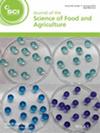Study based on metabolomics and network pharmacology to explore the mechanism of Ginseng‐Douch compound fermentation products in the treatment of hyperlipidemia
IF 3.3
2区 农林科学
Q1 AGRICULTURE, MULTIDISCIPLINARY
引用次数: 0
Abstract
BACKGROUNDGinseng‐Douchi (GD) is a complex fermented product of ginseng and soybean, similar to natto, and is effective in the treatment of hyperlipidemia, but the mechanism of action involved needs to be further explored.RESULTSThe present study combines a comprehensive strategy of network pharmacology and metabolomics to explore the lipid‐lowering mechanism of GD. First, a hyperlipidemia rats model induced by a high‐fat diet was established to evaluate the therapeutic effects of GD. Second, potential biomarkers were identified using serum metabolomics and metabolic pathway analysis was performed with MetaboAnalyst. Third, network pharmacology is used to find potential therapeutic targets based on the blood‐influencing components of GD. Finally, core targets were obtained through a target–metabolite and the enrichment analysis of biomarkers–genes. Biochemistry analysis showed that GD exerted hypolipidemic effects on hyperlipidemic rats. Nineteen potential biomarkers for the GD treatment of hyperlipidemia were identified by metabolomics, which was mainly involved in linoleic acid metabolism, glycerophospholipid metabolism, ether lipid metabolism, alpha‐linolenic acid metabolism and glycosylphosphatidylinositol‐anchor biosynthesis. GD had a callback function for ether lipid metabolism and glycerophospholipid metabolism pathways. Eighteen blood components were identified in serum, associated with 85 potential therapeutic targets. The joint analysis showed that three core therapeutic targets were regulated by GD, including PIK3CA, AKT1 and EGFR.CONCLUSIONThis study combines serum medicinal chemistry of traditional Chinese medicine, network pharmacology and metabolomics to reveal the regulatory mechanism of GD on hyperlipidemia. © 2024 Society of Chemical Industry.基于代谢组学和网络药理学的研究探索人参-杜仲复合发酵制品治疗高脂血症的机制
背景人参豆糜(GD)是人参和大豆的复合发酵产物,类似于纳豆,对治疗高脂血症有一定疗效,但其作用机制有待进一步探讨。结果本研究结合网络药理学和代谢组学的综合策略探讨了GD的降脂机制。首先,通过建立高脂饮食诱导的高脂血症大鼠模型来评估 GD 的治疗效果。其次,利用血清代谢组学鉴定潜在的生物标志物,并使用 MetaboAnalyst 进行代谢通路分析。第三,根据 GD 的血液影响成分,利用网络药理学寻找潜在的治疗靶点。最后,通过靶标-代谢物和生物标志物-基因的富集分析,获得了核心靶标。生化分析表明,广东十一选五对高脂血症大鼠具有降脂作用。代谢组学发现了19个GD治疗高脂血症的潜在生物标志物,主要涉及亚油酸代谢、甘油磷脂代谢、醚脂代谢、α-亚麻酸代谢和糖基磷脂酰肌醇锚生物合成。GD 对醚脂代谢和甘油磷脂代谢途径具有回调功能。在血清中发现了18种血液成分,与85个潜在治疗靶点相关。结论本研究将中药血清药物化学、网络药理学和代谢组学相结合,揭示了GD对高脂血症的调控机制。© 2024 化学工业协会。
本文章由计算机程序翻译,如有差异,请以英文原文为准。
求助全文
约1分钟内获得全文
求助全文
来源期刊
CiteScore
8.10
自引率
4.90%
发文量
634
审稿时长
3.1 months
期刊介绍:
The Journal of the Science of Food and Agriculture publishes peer-reviewed original research, reviews, mini-reviews, perspectives and spotlights in these areas, with particular emphasis on interdisciplinary studies at the agriculture/ food interface.
Published for SCI by John Wiley & Sons Ltd.
SCI (Society of Chemical Industry) is a unique international forum where science meets business on independent, impartial ground. Anyone can join and current Members include consumers, business people, environmentalists, industrialists, farmers, and researchers. The Society offers a chance to share information between sectors as diverse as food and agriculture, pharmaceuticals, biotechnology, materials, chemicals, environmental science and safety. As well as organising educational events, SCI awards a number of prestigious honours and scholarships each year, publishes peer-reviewed journals, and provides Members with news from their sectors in the respected magazine, Chemistry & Industry .
Originally established in London in 1881 and in New York in 1894, SCI is a registered charity with Members in over 70 countries.
文献相关原料
| 公司名称 | 产品信息 | 采购帮参考价格 |
|---|

 求助内容:
求助内容: 应助结果提醒方式:
应助结果提醒方式:


